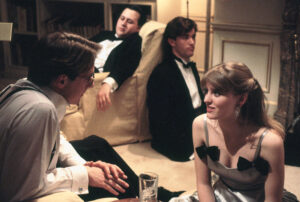
By Lawrence Toppman
Movies never change, but we do. When I first saw Metropolitan in 1990, I was 36 – a year younger than producer-director-writer Whit Stillman when he made it – and I smiled at the romantic and philosophical muddles of preppy college students on Manhattan’s Upper East Side. Now, when the Independent Picture House will hold a 35th-anniversary screening and an in-person discussion with Stillman on April 24, it seems like a forecast of modern America.
These members of the self-titled Urban Haute Bourgeoisie dwell in an unperceived bubble of comfort and safety. (The “less fortunate” Tom Townsend lives with his mother in a pleasant apartment on the Upper West Side and attends Princeton University.) They represent, intentionally or not, the kind of unaware white privilege that prevails in our nation today.
Metropolitan became the first feature in Stillman’s loosely autobiographical trilogy, followed by Barcelona (1994) and The Last Days of Disco (1998). Stillman has made just two features since then and has worked on a couple of TV series, but his Oscar-nominated original screenplay for Metropolitan holds up well.
It follows members of the SFRP (Sally Fowler Rat Pack) as they amble through the debutante season at upper-crust Manhattan hotels. Tom falls for gentle Audrey but abandons her when old flame Serena beckons. Nick claims to loathe this social circle but fears to be cast out; he puts down the others, who tolerate his barbs. Charlie, the unformed conscience of the group, tries to get a grip on its motivations and responsibilities.
When I saw the movie again last week, I realized how much it reminded me of Woody Allen’s work in the same period, from the locales to the plain printed titles on a black screen over jazz music. The characters are all articulate, white, well-to-do, making cultural references to author Jane Austen and French socialist Charles Fourier. Taylor Nichols, who plays Charlie, seems to be a homage to Allen: shy and stammering, lank-haired and bespectacled, yearning for the unreachable Audrey.
The movie has only one character who could be described as a villain, obnoxious serial womanizer Rick Von Sloneker. Yet we come to suspect his conquests are mostly legendary, not real, and the group admits him: No one with money, good looks and social prestige ever gets ostracized. (Oddly, everyone but one pudgy fringe member of the SFRP is slender, making me think of the quote attributed to Wallis Simpson: “You can never be too rich or too thin.”)
As so often happens with antiheroes, Nick begins to take over the film – so much so, I suspect, that Stillman sends him away before the ending, so he won’t overshadow the others. One young woman in the SFRP calls him a snob, a sexist and a hypocrite. He’s also a philanderer, a mean-spirited egotist who demands attention, a guy who mocks “titled aristocrats” but would like to be one, and a liar who makes up hurtful things and remains unrepentant when he’s caught. Why, that lad could grow up to be president of the United States!

